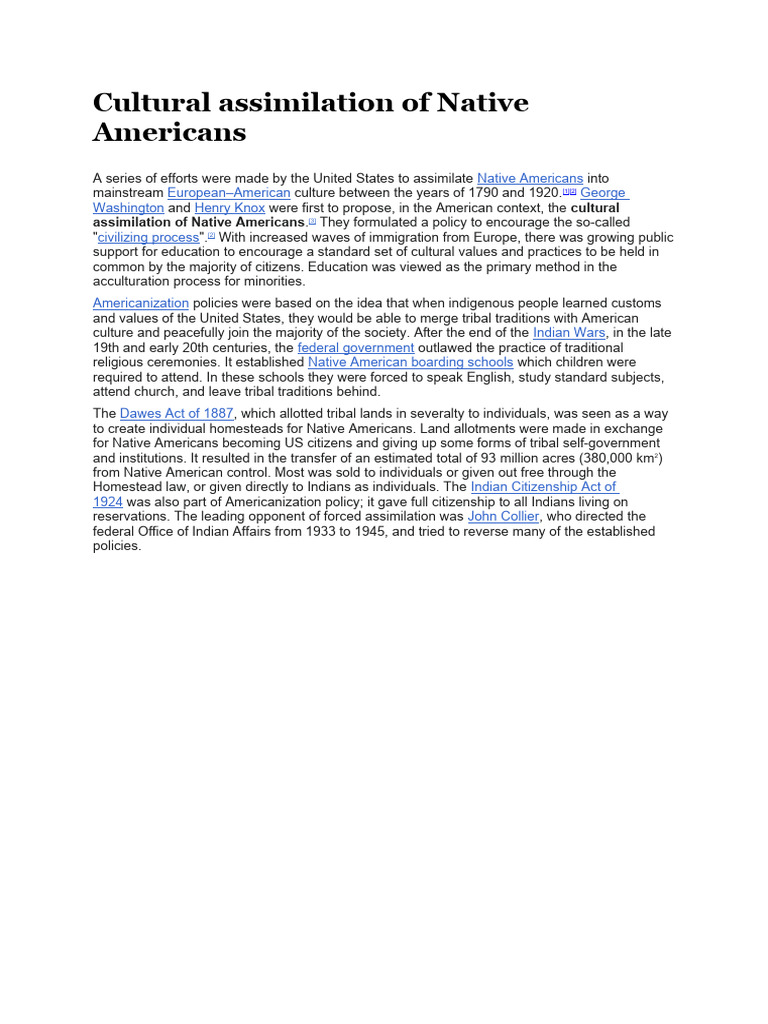The cultural assimilation of Native Americans is a multifaceted phenomenon that encompasses a historical narrative, a series of policies designed to promote the assimilation of Indigenous peoples, and significant implications for cultural relativism. To consider the historical landscape, we must first question: what does it mean to truly “assimilate”? Furthermore, can one culture fully subsume another, or does this process create an amalgamation of identities that challenges traditional notions of cultural purity?
Historically, the contact between Indigenous peoples and European settlers heralded a profound transformation in social structures, economies, and spiritual practices. From the late 15th century onward, as Europeans expanded their territories, they imposed their cultural norms upon Native American societies. The overarching aim was not merely to explore and settle but to redirect and transform Indigenous identities in ways that supported colonial expansion. The settlers often viewed Native cultures as inferior, prompting numerous initiatives aimed at erasing Indigenous practices in favor of Western ideals.
Across North America, federal policies emerged in the 19th and early 20th centuries that were explicitly designed to facilitate the cultural assimilation of Native Americans. The most salient of these policies included the Indian Removal Act of 1830, which forcibly displaced many tribes from their ancestral lands, and the establishment of Indian boarding schools. These institutions, often run by Christian missionaries, aimed to “civilize” Native youth by stripping them of their languages, customs, and even familial connections. The motto “Kill the Indian, save the man” epitomized this paternalistic sentiment, reflecting a misguided belief that the erasure of Indigenous culture was synonymous with progress.
In examining these policies through a cultural relativism lens, one might ponder: how can we reconcile the destructive impact of assimilationist policies with the complex realities of cultural interactions? Cultural relativism posits that a culture should be understood on its own terms rather than judged against the metrics of another. Thus, it prompts us to interrogate the moral implications of imposing one culture onto another—does this not inherently violate the principle of respect for cultural diversity?
The repercussions of assimilationist policies on Native communities have been catastrophic. Language loss, a profound and often irreversible effect, is perhaps the most visible indicator of cultural erosion. Many Native languages have become endangered or extinct, resulting in a disconnection from ancestral knowledge and identity. Notably, the inability to communicate in one’s native tongue can fragment the continuity of cultural practices and the transmission of traditional ecological knowledge, which is vital for the sustenance of communities.
Moreover, the psychological impact of forced assimilation cannot be overstated. Generations of Native Americans were conditioned to internalize a sense of inferiority, leading to social fragmentation and identity crises. The suppression of traditional cultural expressions, religious practices, and communal lifestyles has resulted in a loss of cultural cohesion, thereby rendering some Native communities vulnerable to socio-economic disparities.
In the contemporary landscape, however, there exists a resurgence of cultural pride and an assertion of Native identity. Many Indigenous communities are actively reviving languages and cultural practices that were once suppressed. This phenomenon raises a compelling issue regarding the notion of assimilation: may it, in fact, create a counter-narrative? What challenges arise when a community reclaims its culture in a society that has historically sought to erase it? This active reengagement with cultural roots can be seen as a defiance against the assimilationist paradigm, positing that cultural fusion does not necessitate cultural obliteration.
Furthermore, the resurgence challenges the stereotypical portrayals that have long permeated American consciousness. The rich tapestry of Native American cultures is not a relic of history but an active and evolving set of identities. Thus, rather than viewing assimilation strictly as a unidirectional process, one must recognize the agency of Indigenous peoples in navigating their own cultural destinies.
Importantly, the dialogue surrounding cultural assimilation is incomplete without considering intercultural interactions. While the historical imperative behind assimilation imposed a stark power dynamic favoring settlers, contemporary cultural exchange has the potential to be more reciprocal. Engagement between Native American cultures and the dominant society can take many forms—art, activism, collaboration—in which both parties contribute while respecting each other’s distinct identities. This mutual exchange can challenge preconceptions of authenticity and cultural ownership while fostering a space for co-creation.
In conclusion, the cultural assimilation of Native Americans remains a complex narrative woven into the broader tapestry of American history. It poses critical questions about identity, belonging, and the intricate machinery of power that has historically governed these discourses. As the data of history reveals, the repercussions of assimilation efforts have left indelible marks on Native communities, provoking a profound reconsideration of cultural valuation and reciprocity. The resilience of Native American cultures today stands testament to the enduring spirit of these communities, illustrating that while assimilation may attempt to erase, cultures can persist, adapt, and flourish in ways that defy simplistic categorization.
Ultimately, one must ponder the future: Can dialogue between cultures pave the way for understanding, or will the specter of historical assimilation continue to loom large over the relationships among diverse cultural identities?
